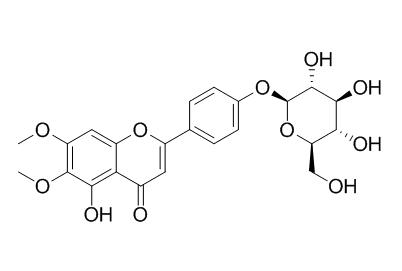Cirsimarin
Cirsimarin shows antioxidant activity; it also exerts potent antilipogenic effect and decreases adipose tissue deposition in mice, it could therefore be a potential candidate for the treatment of obesity.
Inquire / Order:
manager@chemfaces.com
Technical Inquiries:
service@chemfaces.com
Tel:
+86-27-84237783
Fax:
+86-27-84254680
Address:
1 Building, No. 83, CheCheng Rd., Wuhan Economic and Technological Development Zone, Wuhan, Hubei 430056, PRC
Providing storage is as stated on the product vial and the vial is kept tightly sealed, the product can be stored for up to
24 months(2-8C).
Wherever possible, you should prepare and use solutions on the same day. However, if you need to make up stock solutions in advance, we recommend that you store the solution as aliquots in tightly sealed vials at -20C. Generally, these will be useable for up to two weeks. Before use, and prior to opening the vial we recommend that you allow your product to equilibrate to room temperature for at least 1 hour.
Need more advice on solubility, usage and handling? Please email to: service@chemfaces.com
The packaging of the product may have turned upside down during transportation, resulting in the natural compounds adhering to the neck or cap of the vial. take the vial out of its packaging and gently shake to let the compounds fall to the bottom of the vial. for liquid products, centrifuge at 200-500 RPM to gather the liquid at the bottom of the vial. try to avoid loss or contamination during handling.
Inflammation.2022, 45(6):2529-2543.
Cells.2023, 12(1):168.
Phytother Res.2019, 33(5):1490-1500
Int J Mol Sci.2023, 24(8):7442.
Kangwon National University2022, 37(1):29-37
J Cell Biochem.2024, 125(4):e30537.
Dent Mater J.2020, 39(4):690-695
Food Quality and Safety2018, 2:213-219
Animals (Basel).2024, 14(20):2990.
Anal Sci.2019, 35(12):1317-1325
Related and Featured Products
Fitoterapia. 2011 Mar;82(2):168-72.
Flavonoid glycosides from Microtea debilis and their cytotoxic and anti-inflammatory effects.[Pubmed:
20804824 ]
METHODS AND RESULTS:
Two new 5-O-glucosylflavones, 5-O-β-D-glucopyranosyl cirsimaritin (1) and 5, 4'-O-β-D-diglucopyranosyl cirsimaritin (2), four known flavonoids, Cirsimarin (3), cirsimaritin (4), salvigenin (5), 4', 5-dihydroxy-7-methoxyflavone (6), and a norisoprenoid, vomifoliol (7), have been isolated from the aerial parts of Microtea debilis. All isolates were tested for cytotoxicity in human cancer cell lines (Hep G2, COLO 205, and HL-60) and anti-inflammatory activities in LPS-treated RAW264.7 macrophages.
CONCLUSIONS:
Compound 6 was found to be a potent inhibitor to nitrite production in macrophages. Compounds 2, 4, 6, and 7 showed moderate anti-proliferative activity against COLO-205 cells with IC(50) values of 7.1, 13.1, 6.1, and 6.8 μM, respectively.
Int J Obes (Lond). 2010 Nov;34(11):1566-75.
Cirsimarin, a potent antilipogenic flavonoid, decreases fat deposition in mice intra-abdominal adipose tissue.[Pubmed:
20458325 ]
We previously reported that the flavonoid Cirsimarin exerts in vitro a strong lipolytic activity on isolated adipocytes. This study was therefore designed to evaluate in vivo the effects of Cirsimarin on white adipose tissue (WAT) accretion in mice.
METHODS AND RESULTS:
Male CD1 mice were injected daily with either vehicle (intraperitoneal (i.p.)) or Cirsimarin (25 or 50 mg kg(-1) per day, i.p.) for 18 days. Mice were killed and fat pads weighted. Epididymal fat pads were used for cellularity measurement. Effects of Cirsimarin treatment on lipolysis and lipogenesis in WAT were assessed.
Mice treated with 25 or 50 mg kg(-1) per day Cirsimarin showed a decrease in retroperitoneal (-29 and -37% respectively, P<0.005) and epididymal (-25 and -28% respectively, P<0.005) fat pad weights compared with controls. This effect was restricted to intra-abdominal WAT as no difference was noticed for subcutaneous inguinal WAT. The decrease in intra-abdominal WAT accretion was due to a decrease in adipose cell diameter (-5 and -8% for 25 and 50 mg kg(-1) per day Cirsimarin, respectively) resulting in a 14 and 35% decrease in adipose cell volume while no change was noticed in total adipocyte number. Direct injection of Cirsimarin (50 mg kg(-1)) to rats did not trigger lipolysis. In contrast, Cirsimarin showed in vivo as well as in vitro a strong antilipogenic activity, which may be the critical aspect of its effects on fat accretion in mice. The inhibitory concentration 50% of Cirsimarin on lipogenic activity in isolated adipocytes was found to be 1.28±0.04 μM. Cirsimarin given orally reduced intra-abdominal fat accretion in mice.
CONCLUSIONS:
Cirsimarin exerts potent antilipogenic effect and decreases adipose tissue deposition in mice. Cirsimarin could therefore be a potential candidate for the treatment of obesity.
Arch Pharm Res. 2008 Jan;31(1):28-33.
Comparative antioxidant activity and HPLC profiles of some selected Korean thistles.[Pubmed:
18277604]
As yet, no comparative analyses have been conducted regarding the comparative antioxidant activities and HPLC profiles of thistles distributed in Korea. Thus, this study was performed in order to evaluate the antioxidant potentials of seven Korean thistles: Cirsium lineare, Cirsium chanroenicum, Cirsium setidens, Cirsium japonicum var. ussuriense, Cirsium nipponicum, Cirslum pendulum and Carduus crispus, via peroxynitrite and DPPH free radical assays.
METHODS AND RESULTS:
Among seven Korean thistles, Carduus crispus exhibited the most significant antioxidant activity in both DPPH assay and peroxynitrite. In order to characterize the compounds contained in Korean thistles, we conducted HPLC analyses on the following ten flavonoids: luteolin-5-glucoside (1), luteolin-7-glucoside (2), apigenin-7-glucoside (3), hispidulin-7-neohesperidoside (4), apigenin-7-glucuronide (5), Cirsimarin (6), pectolinarin (7), luteolin (8), apigenin (9) and acacetin (10).
CONCLUSIONS:
The results of our HPLC analyses indicated the presence of pectolinarin in the whole plants of C. setidens, C. lineare, C. nipponicum, C. pendulum, the aerial and underground parts of C. japonicum var. ussuriense, and the aerial parts of C. chanroenicum. Moreover, we were able to identify hispidulin-7-neohesperidoside and luteolin-7-glucoside in the whole plants of Carduus crispus, acacetin in the aerial parts of C. chanroenicum, Cirsimarin in C. lineare.



